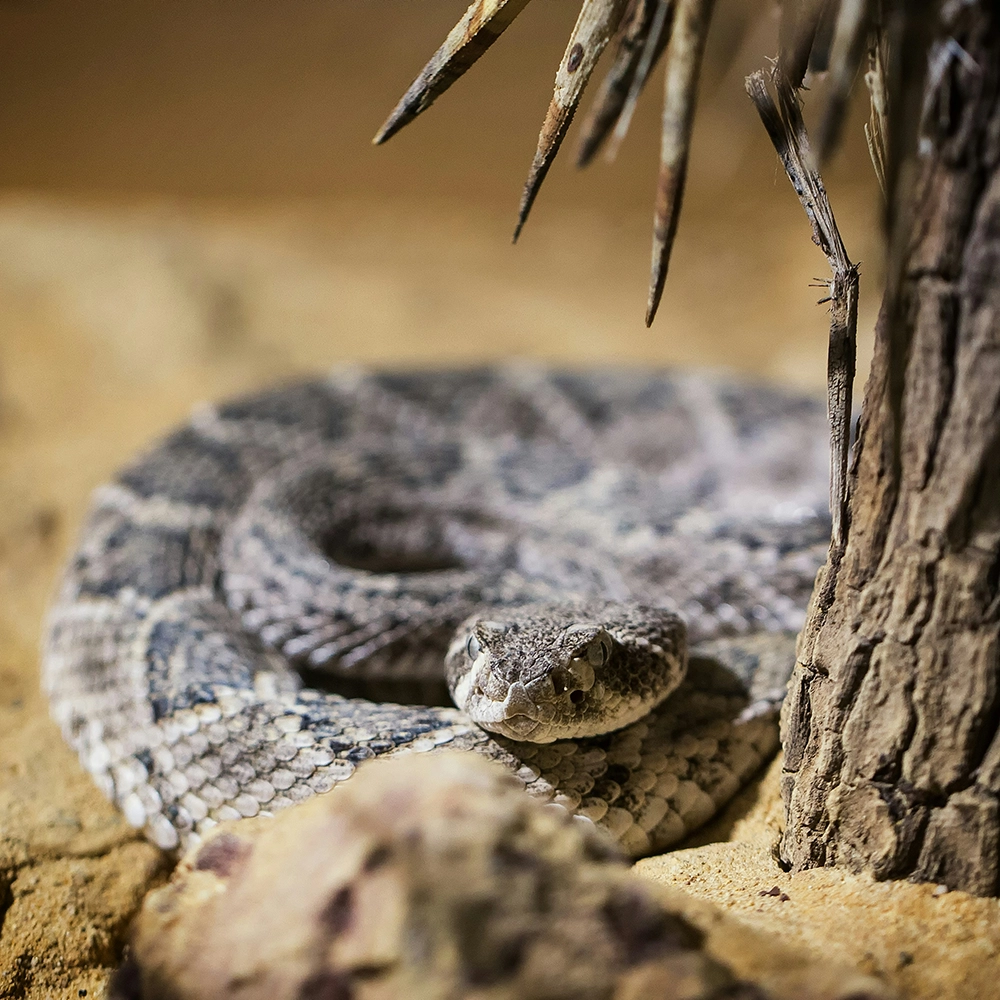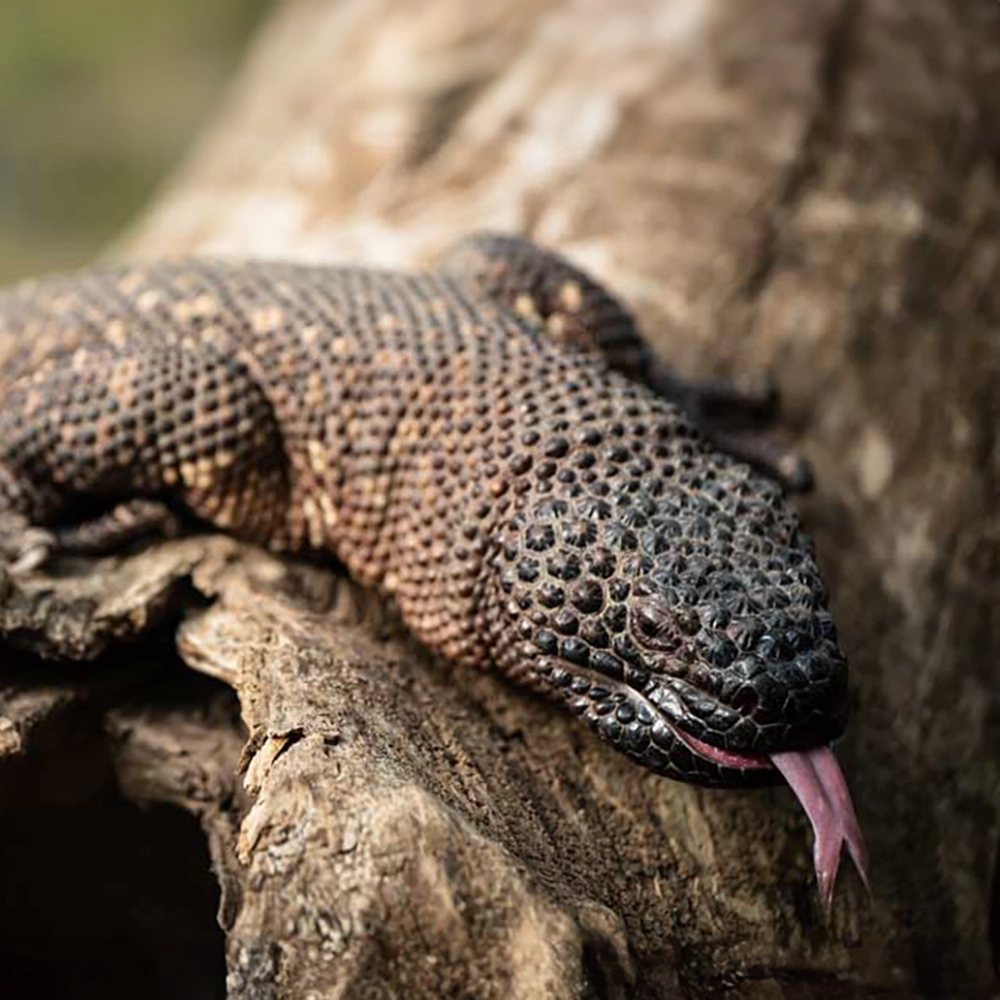We enter the Guatemalan compound and are greeted by two women making tortillas in the entrance.
"Hola!" they say, and I hope one is going to offer us a tortilla, but they do not, and this makes me sad.
The tortilla ladies are also the security guards. The best way to keep a facility like this protected is to install a local family to live there in exchange for their vigilance. In large Latino families, someone is always home.
“Nice pool,” I tell biologist Matt Norgren as he leads me along the edge of an Olympic-size pool housed within the compound. But we aren't here to swim.
Based on what happens next, it appears we are here so Matt can frighten me with the one thing that terrifies even Indiana Jones!
Snakes. Lots of them, each in a crate-sized terrarium, newly arrived and waiting to be used as evidence in upcoming court cases. Their previous owners face charges related to owning, transporting, or selling reptiles without the proper permits.
Matt goes straight for the rattlesnakes, opens one of the tanks, and picks up a demure six-foot rattler before setting it on the floor of the room.
I have come to this compound to see the rare pair of beaded lizards, but clearly, I first have to get past this rattlesnake first.
Instead of going straight for my jugular vein as I imagine it would, the snake curls up calmly on the floor and appears to fall asleep. He's happy, it seems, to be free of the small box he now lives in.
Animals in Danger
Ask the animals and they will tell you that human beings make significantly less sense than the platypus, which is to say, not very much. Collectively, we make about as much sense as fasting at a wedding feast.
Our species is pushing many others to extinction, yet for every animal on the brink of existence, there are a few oddball human beings passionately dedicated to ensuring their survival.
Matt Norgren is one such oddball. His specialty is herpetology (that's the study of reptiles), and he’s a volunteer here at Antigua Exotic in San Felipe, Guatemala, a reptile sanctuary housing two examples of one of the rarest reptiles on earth — the beaded lizard.
Matt speaks about the beaded lizards like they're sacred. "The Guatemalan subspecies of the beaded lizard is almost gone," he says. "If they don't get some serious help, goodbye lizard."
Antigua Exotic Reptile Rescue Center
Despite its name, The Antigua Exotic Reptile Rescue Center is not located in the famed colonial city of Antigua, Guatemala. Instead, you’ll find it in San Felipe. Maybe, that is, if you know who to ask.
Look for the mariachis in San Felipe’s central plaza and ask where the snakes are. They’ll send you down several dusty alleyways, admittedly to an unlikely place known as the country’s premier amphibian and reptile center.
It was founded by Danny Mazariego, a Guatemalan man keen on protecting the reptiles his own government does little to safeguard. Funding comes from Danny's father, a dentist who believes in his son's mission to protect his country’s threatened reptiles, and renting out that Olympic-size pool I saw when I got here.
Prior to the refugee’s existence, there was nowhere local for confiscated reptiles to be taken. CONAP, the enforcement body of safeguarding confiscated animals, now brings the animals to Antigua Exotic and has begun sporadically donating food to the center.
Safety in an Unprotected Land
After looking at the recent arrivals in the evidence room, Matt puts the rattlesnake back in his crate. We walk back through the courtyard, past the caimans and tortilla ladies to the permanent breeding/housing room. It’s lined with terrariums decked out to make the reptiles feel like this isn’t a cage but a home. There are sticks to climb, rocks to hide under — everything snakes and lizards love!
As we make our way through the room, Matt describes each snake, its situation, its health, where it came from, and why it should not be here.
"Half of these shouldn’t even be in Guatemala,” he says. “And the ones being flagged by Customs are probably a drop in the bucket of how many animals are coming and going in the illegal reptile trade."
The two beaded lizards — the crown jewels of the sanctuary — came out of the same German suitcase. Since there’s scant many of them, people will pay up to $10,000 for a Guatemalan beaded lizard.
But instead of being the showpiece of some foreign illegal reptile garden, the beaded lizards landed in the best terrarium in the refuge. It occupies its own corner of a building, its place of prominence saying, “These lizards are special.”
Matt leaves to get a key so that we can hold the lizards.
"These are one of two venomous species of lizards on earth," he says opening the case.
He should have told me that before fetching the key. I have laundry to pick up later and can't afford a lethal lizard bite.
The Healing Power of Venomous Lizards
While snakes all seemed to think that evolution owed them venom to make up for the legs they didn’t get, globally only two known species of lizards — the Gila monster and its cousin, the beaded lizard — developed venom capable of harming humans.
Though venomous, the beaded lizard’s docile nature means they’re not a threat to humans. In fact, they could possess a great gift for humanity should they survive long enough for the toxins in their venom to be studied. It was a compound isolated in Gila monster venom that led to the drug Exenatide, which the FDA has approved to treat type 2 diabetes.
From the pain killing medication made from black mamba venom to ACE inhibitor medicine from pit viper venom, the science that studies venom has shown that a great many medical breakthroughs have come from the relatively miniscule amount of reptilian toxins studied containing more than 40 million biologically active molecules, only 0.00005% have been categorized, much less studied with enough depth to reveal their therapeutic and healing potential.
Play Date with the Most Endangered Reptiles in the World
Matt carries each of the lizards into the outside courtyard. One thing is clear: I have nothing to fear. Beaded lizards are like puppies. They sit on your lap and chill with you. Their faces are large, and filled with a cold, but piercing reptilian intelligence.
Though their venom could lead to respiratory failure in humans, as long as you don’t annoy them, you’re fine. Of the eight documented bites in the last 100 years, all were due to indiscreet poking and prodding, jerk moves as far as the beaded lizard is concerned.
On the pavement in the courtyard, the slightly larger lizard walks back and forth between us. Because they are this docile, they are easy pickings for poachers, hunters, habitat destruction, and pleasure killings that occur because some people think it’s fun to shoot living things. Hence, the lizard’s rarity.
When their final price fetches as much as an impoverished farmer would make in a decade, protecting them from destitute people who see them as liberating financial opportunities is not easy. And without a major breeding program, the lizards before me might be the last of their kind.
Breeding the Beaded Lizard in Captivity
Only two zoos in the United States have successfully bred Guatemalan beaded lizards, most recently at Zoo Atlanta. And because it’s estimated that fewer than 600 beaded lizards remain in the wild, the best hope for the species’ survival is continued funding and the expansion of existing breeding programs.
The beaded lizards need the directed passion of the few oddball humans like Matt and Danny, who are fervent about spreading awareness of their peril and working to secure funding for programs that protect their future.
As the two beaded lizards waltzed around the courtyard, they soaked up the sun, content it seemed, and unaware just how precarious the existence of their species is.
Rewilding as Sustainable Travel
There are many ways you can travel sustainably, to not only reduce the negative impact you have on the environment, but also to make an even bigger positive one. Check out the Seven Corners blog to learn more about rewilding projects to join for an eco-friendly vacation and other sustainable travel tips.


